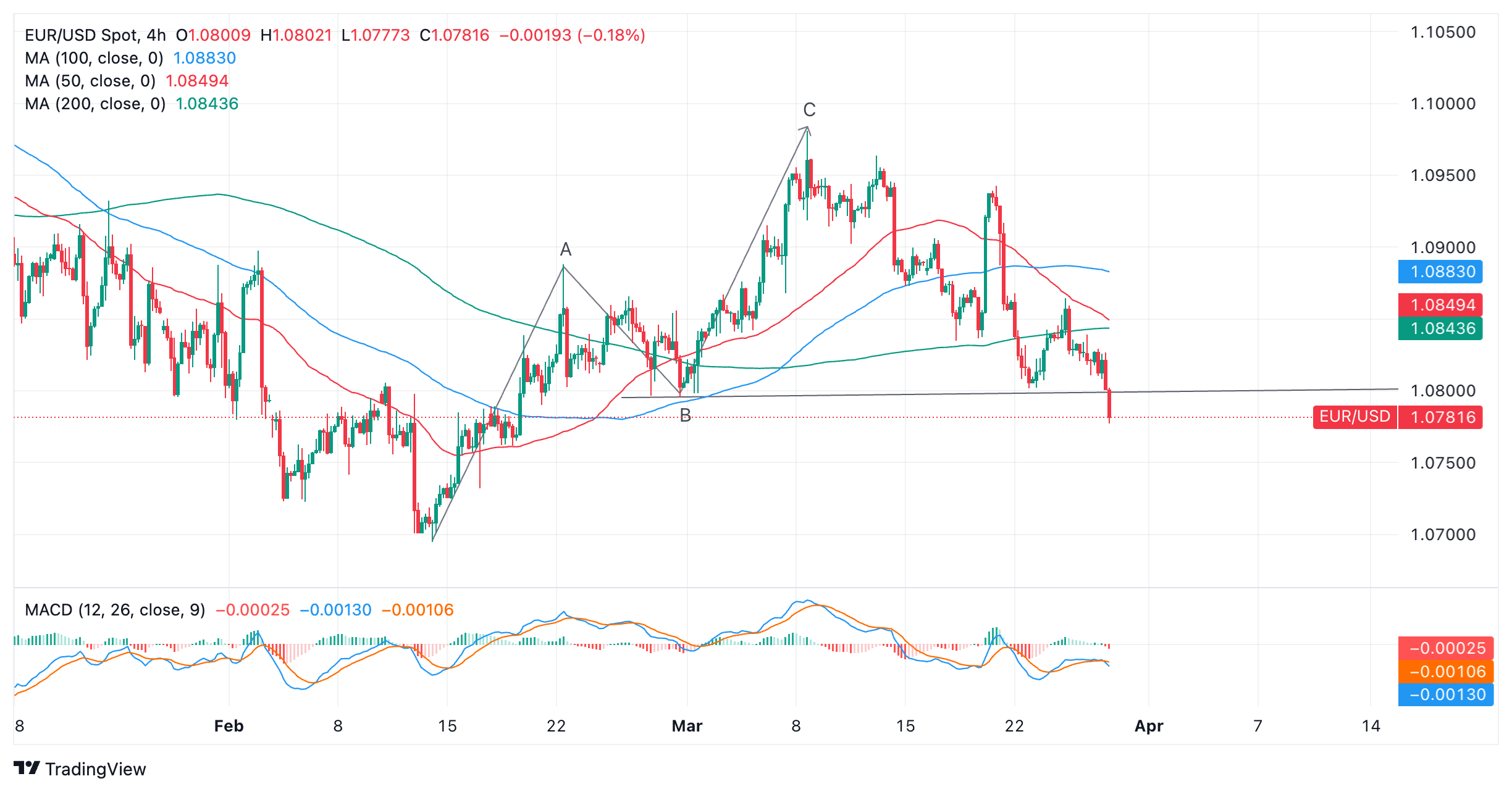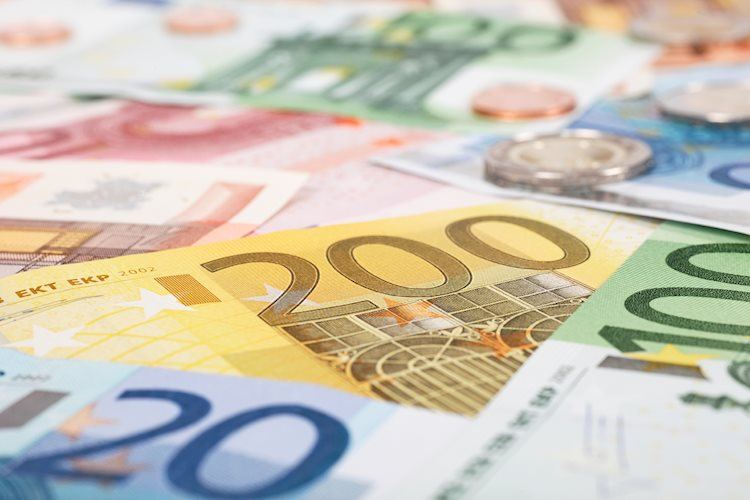EUR/USD declines after disappointing German Retail Sales
- EUR/USD takes another step lower on poor German Retail Sales data.
- Subdued consumer spending levels in Germany increase the probability the ECB will cut interest rates soon.
- This contrasts with the US, where Fed officials are advocating a delay in rate cuts.
EUR/USD sells off on Thursday, breaking below key support at 1.0800 after the release of subpar German Retail Sales data raised further concerns over the health of Europe’s largest economy, weighing on the Euro (EUR). The pair is also pressured lower by a backdrop of the Federal Reserve (Fed) increasingly looking like it will delay cutting interest rates in light of more robust economic data and stickier inflation.
EUR/USD downtrend continues on fears Fed could delay cuts
EUR/USD’s move down extends the short-term downtrend that started after the rollover from the March 8 highs in the 1.0980s. The main catalyst appears to be the diverging commentary from rate-setters at the US Federal Reserve (Fed) and European Central Bank (ECB).
Whilst at the beginning of March the ECB was signaling it would cut interest rates by June and the Fed potentially by as early as May, recent higher-than-expected US data and sticky inflation has led many Fed officials to question whether it may be too early to start cutting interest rates.
The view the Fed may keep interest rates higher for longer has supported the US Dollar (USD) because higher interest rates tend to attract more foreign capital inflows. This is bearish for EUR/USD, which measures the buying power of a single Euro in USD terms.
On Wednesday, Federal Reserve board member Christopher Waller added his voice to those advocating a delay, saying that “there is no rush to cut the policy rate,” in a speech to the Economic Club of New York, according to Reuters.
ECB officials, on the other hand, have cleaved increasingly to June. Eurozone economic data has been on the whole disappointing compared to US data, although persistently high wage inflation still concerns some policymakers.
EUR/USD took another step lower on Thursday after German Retail Sales in February showed shoppers on the whole tightening their purse strings. Weakening consumer spending is another sign inflation will come down further, prompting the ECB to cut interest rates.
Retail Sales fell 2.7% YoY in Germany, which was far below estimates of a 0.8% decline, according to data from Statistisches Bundesamt Deutschland. Month-on-month the 1.9% decrease must have come as a shock after economists predicted a 0.3% rise.
Friday’s US core Personal Consumption Expenditures (PCE) Price Index data for February – the Fed’s preferred gauge of inflation – is likely to be an even more important release for EUR/USD.
A higher-than-expected result could push even further back the time when the Fed is expected to cut interest rates, with negative consequences for the pair.
Technical Analysis: EUR/USD continues pushing lower
EUR/USD extends the dominant short-term downtrend that started at the March 8 high. It has now broken below key support at around 1.0800.

Euro versus US Dollar: 4-hour chart
The pair formed a three wave price pattern called a Measured Move back in February and early March and the low of wave B provided the underpinning for key support at just above 1.0800.
If the break in progress proves decisive it would signal a continuation of the downtrend even lower, to the next target at 1.0750, followed by the February lows at roughly 1.0700.
A decisive break is one characterized by a long red bearish candle that breaks cleanly through the level and closes near its low, or three down candles in a row that breach the level.
Alternatively, a move above the 1.0950 level would bring into question the validity of the short-term downtrend.
Euro FAQs
The Euro is the currency for the 20 European Union countries that belong to the Eurozone. It is the second most heavily traded currency in the world behind the US Dollar. In 2022, it accounted for 31% of all foreign exchange transactions, with an average daily turnover of over $2.2 trillion a day. EUR/USD is the most heavily traded currency pair in the world, accounting for an estimated 30% off all transactions, followed by EUR/JPY (4%), EUR/GBP (3%) and EUR/AUD (2%).
The European Central Bank (ECB) in Frankfurt, Germany, is the reserve bank for the Eurozone. The ECB sets interest rates and manages monetary policy. The ECB’s primary mandate is to maintain price stability, which means either controlling inflation or stimulating growth. Its primary tool is the raising or lowering of interest rates. Relatively high interest rates – or the expectation of higher rates – will usually benefit the Euro and vice versa. The ECB Governing Council makes monetary policy decisions at meetings held eight times a year. Decisions are made by heads of the Eurozone national banks and six permanent members, including the President of the ECB, Christine Lagarde.
Eurozone inflation data, measured by the Harmonized Index of Consumer Prices (HICP), is an important econometric for the Euro. If inflation rises more than expected, especially if above the ECB’s 2% target, it obliges the ECB to raise interest rates to bring it back under control. Relatively high interest rates compared to its counterparts will usually benefit the Euro, as it makes the region more attractive as a place for global investors to park their money.
Data releases gauge the health of the economy and can impact on the Euro. Indicators such as GDP, Manufacturing and Services PMIs, employment, and consumer sentiment surveys can all influence the direction of the single currency. A strong economy is good for the Euro. Not only does it attract more foreign investment but it may encourage the ECB to put up interest rates, which will directly strengthen the Euro. Otherwise, if economic data is weak, the Euro is likely to fall. Economic data for the four largest economies in the euro area (Germany, France, Italy and Spain) are especially significant, as they account for 75% of the Eurozone’s economy.
Another significant data release for the Euro is the Trade Balance. This indicator measures the difference between what a country earns from its exports and what it spends on imports over a given period. If a country produces highly sought after exports then its currency will gain in value purely from the extra demand created from foreign buyers seeking to purchase these goods. Therefore, a positive net Trade Balance strengthens a currency and vice versa for a negative balance.
Forex News
Keep up with the financial markets, know what's happening and what is affecting the markets with our latest market updates. Analyze market movers, trends and build your trading strategies accordingly.
